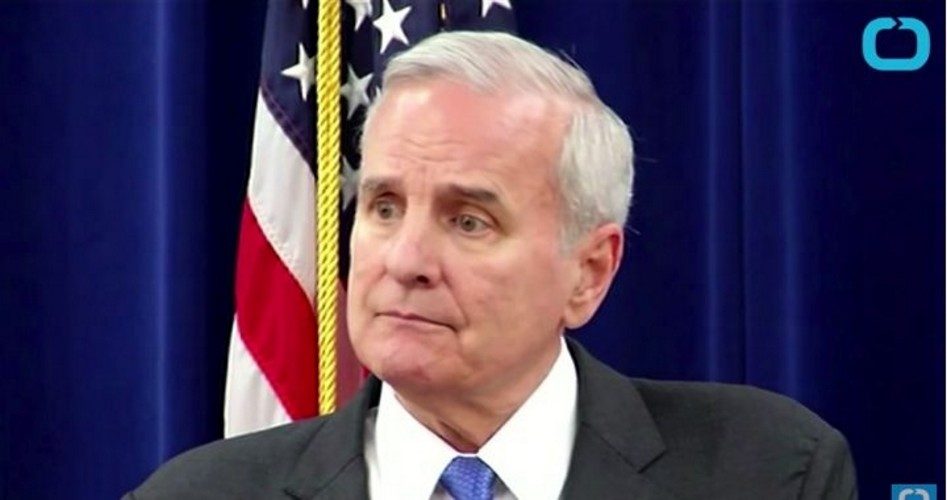
Minnesota Governor Mark Dayton (shown) on Wednesday became the latest Democrat to state publicly that the Affordable Care Act (ACA) is anything but affordable. “The Affordable Care Act has many good features to it … but it’s got some serious blemishes right now and serious deficiencies,” Dayton, previously an enthusiastic backer of the ACA, said.
“The reality,” he declared, “is the Affordable Care Act is no longer affordable for an increasing number of people.”
The big problem in the Gopher State is that health insurers are hiking individual insurance rates steeply, in large measure “because of a disproportionate concentration of individuals with serious medical conditions whose high claims costs must be absorbed by a relatively small risk pool,” according to a September 30 press release from Minnesota Commerce Commissioner Mike Rothman, a Dayton appointee.
This was, of course, to be expected from a law that makes insurance a bargain for those with costly, chronic conditions, even guaranteeing them acceptance, but a raw deal for those who are healthy. The aged and infirm not covered by Medicare and Medicaid have rushed to buy coverage on the exchanges, while the young and healthy have stayed away — the beginning of the “death spiral” so many ObamaCare critics have long forecast.
Approximately five percent of Minnesotans (about 250,000) obtain their health insurance on the individual market. For 2017, they are facing premium increases between 50 percent and 67 percent. “The massive increases are among the largest in the nation and come amid shrinking provider networks on health insurance plans,” reported the St. Paul Pioneer Press. “Additionally, many counties outside of the Twin Cities metro area will have more limited choices of health insurers.”
“It’s a very serious problem,” said Dayton.
ObamaCare supporters frequently point to the fact that people can get subsidies to buy insurance, which helps to mask the exorbitant premiums the healthcare law has helped to bring about. “But,” noted the Pioneer Press, “people who earn more than $47,520 for an individual or $97,200 for a family of four don’t qualify for subsidies. Neither do people who bypass [the state’s ACA exchange] and buy insurance directly from insurance companies.”
“While federal tax credits will help make monthly premiums more affordable for many Minnesotans, these rising insurance rates are both unsustainable and unfair,” Rothman said in his press release. “Middle-class Minnesotans in particular are being crushed by the heavy burden of these costs…. They say that health insurance is unaffordable, and they’re right.”
Another issue for Minnesotans is the dwindling number of insurance providers. Blue Cross Blue Shield of Minnesota announced in June that it is withdrawing from the state’s individual market, a move that affects about 40 percent of those buying individual insurance. According to Rothman, the market for 2017 “was on the verge of collapse” as all other insurers threatened to leave as well. The state persuaded them to remain, but most are limiting the number of beneficiaries they will accept. “Outside of the Twin Cities metro area, individual market customers might find their preferred doctor outside of their network,” wrote the Pioneer Press.
Minnesota is hardly alone in its ObamaCare woes. Chris Conover of Forbes recounted:
Obamacare continues to be a slow-motion train wreck. An analysis by Charles Gaba (an ACA supporter) shows that average premium increases in the non-group market will average 24% for 2017. Last month’s decision by Aetna (the nation’s third largest insurer) to dump 80% of its Obamacare subscribers for 2017 came on the heels of the decision by UnitedHealth (the nation’s largest health insurer) to likewise cut back enormously on its participation in the Obamacare exchanges (3 states in 2017 vs. 34 states this year). Yet another of the nation’s “big 5” health insurers, Humana, will offer coverage in just 156 counties in 2017, 88 percent fewer than this year.
It was for precisely these reasons that former President Bill Clinton recently called ObamaCare “the craziest thing in the world.” It may have helped some people, he said, but “then the people who are out there busting it, sometimes 60 hours a week, wind up with their premiums doubled and their coverage cut in half.”
And that’s assuming one is able to get 60 hours of work a week if he wants it. Conover pointed out that an August “survey by the Federal Reserve Bank of New York found that 20.9% of manufacturing firms in the state said they were employing fewer workers because of Obamacare, while 16.8% of respondents in the service sector said the same.”
Dayton and other Democrats believe the answer to their ObamaCare troubles lies in mere reform of the law. “Dayton said the state may look at giving insurers greater flexibility and he will examine, after the November election, whether an emergency special session could give Minnesotans some relief from health care cost increases,” the Pioneer Press penned. “The governor said the federal government should also play a role, perhaps by offering greater tax credits to consumers or making other significant changes.”
Even Republicans seem to believe the law isn’t fundamentally bad and just needs some tinkering to make it work. “I guess it’s better late than never, but Minnesota Republicans pointed out these flaws and tried to pass amendments to the legislation when Democrats under single party rule first passed it without a single Republican vote,” Minnesota GOP chairman Keith Downey said in a statement Wednesday. “And since then Republicans have repeatedly proposed solutions, but the Democrats shot them all down.”
The fact is that the ACA is both unconstitutional and unworkable. It cannot be successfully reformed because it attempts to substitute central planning for the invisible hand of the free market, as if a handful of politicians and bureaucrats in Washington could possibly micromanage the healthcare of 320 million people to everyone’s satisfaction. Now, as in 2010, the only genuine solution for it is repeal.



